
Related
Guests
- Mark Braylecturer at Dartmouth College. His new book is Antifa: The Anti-Fascist Handbook.
President Trump is facing widespread criticism for his latest comments on the deadly white supremacist protest in Charlottesville, Virginia. On Tuesday, Trump said the violence was in part caused by what he called the “alt-left.”
We continue our conversation with Mark Bray. He is a lecturer at Dartmouth College. His new book is “Antifa: The Anti-Fascist Handbook.”
Transcript
AMY GOODMAN: This is Democracy Now!, democracynow.org, The War and Peace Report. I’m Amy Goodman.
President Trump is facing widespread criticism for his latest comments on the deadly white supremacist protest in Charlottesville, Virginia. Speaking at Trump Tower Tuesday, Trump said the violence was in part caused by what he called the “alt-left.”
We now bring you Part 2 of our conversation with Mark Bray, lecturer at Dartmouth College. His new book, Antifa: The Anti-Fascist Handbook.
In Part 1, Mark, we talked about the origins of antifa, but just for the beginning here, explain what antifa is.
MARK BRAY: Right. So, antifa is a pan-left politics of social revolution applied to fighting the far right. It believes in using direct action rather than turning to the state or the police to stop the fascist advance. And it includes anarchists, communists, socialists, across the political spectrum, and really dates back decades. They’re people who are really not going to allow fascists and Nazis any room to organize. One of their main kind of slogans is “No platform for fascism.”
AMY GOODMAN: I want to read from The New York Times. They wrote, “[O]verall, far-right extremist plots have been far more deadly than far-left plots … in the past 25 years, according to a breakdown of two terrorism databases by … an analyst at the libertarian Cato Institute.
“White nationalists; militia movements; anti-Muslim attackers; I.R.S. building and abortion clinic bombers; and other right-wing groups were responsible for 12 times as many fatalities and 36 times as many injuries as communists; socialists; animal rights and environmental activists; anti-white- and Black Lives Matter-inspired attackers; and other left-wing groups,” the Times wrote. Mark Bray?
MARK BRAY: Yes. Well, it’s certainly true that, in terms of body counts, in terms of raw violence, the far right, now and in the past, has much more blood on their hands. But I also want to encourage viewers to think not only in terms of numbers of comparing body counts, not only in terms of violence in the abstract, but the values and context of violence. So, you know, when anti-racists defend themselves violently, it’s different from when racists attack people of color, queer and trans people, with violence. So, it’s certainly true that the far right are much more violent, but I don’t think that we can exclusively think of it in terms of numbers.
The other thing that I want to encourage viewers to think about is that the term “terrorism” usually is used in a way that essentially legitimizes state violence and police violence. Historically, the greatest sources of violence have come from states and have come from their armies and police, but is not labeled terrorism. So, I think, instead of thinking in terms of the sort of seemingly neutral concepts of terrorism or violence or body counts, let’s also think in terms of politics and context.
AMY GOODMAN: I asked you earlier about Sebastian Gorka, inside the White House. I wanted to play a clip for you of what he had to say after the bombing of the mosque in Minneapolis, that just happened a few weeks ago. President Trump did not tweet about it. A week before events unfolded in Charlottesville, the Dar Al-Farooq Islamic Center in Bloomington, Minnesota, attacked, an act that the governor of Minnesota called “terrorism.” Speaking to the AP, Congressman Keith Ellison condemned Trump for not speaking out about the attack, saying, “It suggests that his oath to protect and defend the Constitution of the United States, including the right to equal protection under the law, only extends to people who meet certain racial and religious criteria.” Ellison’s comments came after the deputy assistant to the president, Sebastian Gorka, suggested on MSNBC that the Minnesota mosque bombing was a “false flag” attack.
SEBASTIAN GORKA: There’s a great rule: All initial reports are false. You have to check them. You have to find out who the perpetrators are. We’ve had a series of crimes committed, alleged hate crimes, by right-wing individuals in the last six months, that turned out to actually have been propagated by the left. So let’s wait and see. Let’s allow the local authorities to provide their assessment, and then the White House will make its comments.
AMY GOODMAN: So that’s Sebastian Gorka, one of the advisers to President Trump. Talk about who he is.
MARK BRAY: Right. So, Sebastian Gorka is one of Trump’s advisers and has documented links to far-right white supremacist factions. And really, this comment shows how the Trump administration cannot accept the fact that what they refer to as “terrorism” is predominantly a white nationalist threat in this country. And they cannot accept the fact that their attempts to simply shine that lens onto the groups like ISIS and al-Qaeda, and therefore implicate Muslim and immigrant communities, is actually, even by their own standards, misguided, in terms of the raw amount of damage and destruction caused through these kinds of unwarranted attacks. So, that’s another reason why anti-fascists focus on confronting the far right, to cut them off from their abilities to access these kinds of high ranks of power.
AMY GOODMAN: President Trump’s counterterrorism adviser, Sebastian Gorka, has been facing calls for his resignation, after the Jewish American newspaper The Forward reported that Gorka is a sworn member of a Hungarian far-right Nazi-allied group. The Forward reported that members of the Vitézi Rend have confirmed Gorka took a life-long oath of loyalty to their group, which the U.S. State Department says was under the direction of the Nazi government of Germany during World War II. If the report is true, it means Gorka may have lied on his U.S. immigration application, which requires people to disclose ties to such organizations. He has denied reports of his involvement with the Nazi-allied group, telling Tablet magazine, “I have never been a member of the Vitez Rend.” If you could talk about the significance of this, Mark Bray?
MARK BRAY: Right. Well, it shows that, just like Bannon’s connections to Breitbart, Gorka really—his values don’t even reflect those of the Republican Party, not that those are values that I stand up for. So, we need to be really vigilant about the fact that Trump is a racist, that Trump is not so casually supporting white nationalist principles and politics, and that he’s—you know, if this is what he says in public, imagine what he’s saying in private. So, certainly calls for him to get rid of Gorka and get rid of Bannon and so forth are really important. We need to also push to get rid of Trump and then keep pushing and really create a broad anti-racist movement that can deal with whoever comes next.
AMY GOODMAN: Can you talk about those who criticize antifa for—or some members in it, for violence? Your response to that?
MARK BRAY: Right. Well, the question of violence needs to be situated historically. So, in the 1920s, ’30s and ’40s, part of the problem is that, across the political spectrum, many people did not take this threat seriously until it was too late. By not confronting them with their fists, they ended up having to confront them with tanks. And so, today, anti-fascists have drawn the historical lesson that because neo-Nazis and fascists are violent, because they have a documented tendency, not only in the past, but today, of attacking left events—for example, I spoke to an immigrant rights activist in Stockholm, Sweden, who said that there had to be anti-fascists at their immigrant rights demonstrations to be ready for the frequent situation where neo-Nazis would show up with knives and broken bottles to attack them.
So, the other thing is, when we talk about violence and anti-fascism, we need to be aware that, historically and today, it has to be situated within self-defense—self-defense, understand, in an immediate sense and in a preemptive sense that’s historically informed and recognizes that if we don’t stop them now, we may not be able to stop them later. That’s really the question that anyone who is opposed to antifa self-defense needs to be able to answer, is: When is enough enough? And when is it legitimate to stand up to these people by any means that is—that are necessary based on the circumstance?
AMY GOODMAN: Can you talk about who the Redneck Revolt are?
MARK BRAY: Right. Redneck Revolt is a network of groups all around the country—I think now they have close to 30 chapters around the country—that essentially tries to target the fact that much of the white working class, that attend gun shows and that live especially in rural parts of this country, had been won over to the right. So, by showing up to gun shows, by promoting anti-racist propaganda, and also by pushing back against liberal opposition to bearing arms, they’ve managed to really build bridges with a lot of working-class white people, bring them over to their side and create, essentially, armed self-defense units around the country. For example, we’ve seen, in Arizona and elsewhere, they’ve showed up with the Brown Berets and other groups bearing arms at far-right, “alt-right” demonstrations. So, it’s really an attempt to sort of create a gun culture of self-defense on the far left and also create points of interaction with segments of the population, with working-class white people, who will all too often feel alienated by what they perceive to be sort of a liberal disdain for them.
AMY GOODMAN: Let me read from a new piece in The Atlantic by Peter Beinart. He writes, quote, “But for all of antifa’s supposed anti-authoritarianism, there’s something fundamentally authoritarian about its claim that its activists—who no one elected—can decide whose views are too odious to be publicly expressed. That kind of undemocratic, illegitimate power corrupts. It leads to what happened this April in Portland, Oregon, where antifa activists threatened to disrupt the city’s Rose Festival parade if people wearing 'red maga hats''—you know, the “Make America Great Again” hats—”marched alongside the local Republican Party. Because of antifa, Republican officials in Portland claim they can't even conduct voter registration in the city without being physically threatened or harassed. So, yes, antifa is not a figment of the conservative imagination. It’s a moral problem that liberals need to confront.” That’s Peter Beinart, writing for The Atlantic. Mark Bray?
MARK BRAY: Right. So, part of the accusation that’s frequently leveled against antifa is the “slippery slope” argument, understood abstractly. So, the argument goes, antifa get to sort of randomly decide who they don’t like, and shut them down, therefore, authoritarianism. But the historical record shows that antifa groups focus on the far right, focus on neo-Nazis and white supremacists. And when those groups are successfully disrupted, there is a long track record of antifa groups essentially disassembling and focusing on other issues. The notion that it’s authoritarian to shut down authoritarianism would not feel very comfortable if we’re thinking about, for example, opposition to Nazis before they got into power in Germany in the late ’20s. Were the communists and anarchists who were defending themselves against Nazis in 1929 authoritarian because they wanted to stop Nazism? That sounds ridiculous, right?
So, once again, as we discussed in the first part of the interview, it’s an example of a kind of all-or-nothing fascism where, in the absence of an immediate threat of a fascist regime, shutting down someone’s opinions—and, of course, that’s how far-right politics are often understood, as opinions, that could just as easily be interchanged with any others, when anti-fascists start the “no platform,” which misses, of course, the politics behind it—that these opinions are the lens that it’s examined at, out of context, out of political focus. So, you know, it really is missing the point historically and analytically, and really missing the ways that a lot—a lot of “alt-right” people are infiltrating the Republican Party.
The Republican Party is now, to some extent, starting to stand up to the far right but needs to do a lot more. And we need to recognize that the far right will try to hide behind the legitimacy that Trump has given their politics, but that anti-fascists aren’t willing to—to stop it. And, now, if Beinart saw, for example, you know, Nazis in the 1920s or 1930s marching along a mainstream parade with swastikas, would it have been inappropriate, considering that the Nazi Party back then was a mainstream party, to have tried to disrupt that? You know, those are the kinds of comparisons that need to be made in discussing this question.
AMY GOODMAN: Mark Bray, can you talk about how President Trump has energized the movement? I mean, it’s—he’s certainly energized the white supremacists, Klan, white nationalist movement. But when it comes to antifa?
MARK BRAY: Right. So, as we know, the term “antifa” is new to mainstream American discourse. It really came into the public view around when anti-fascists disrupted Milo Yiannopoulos at UC Berkeley back in early February. But prior to that, especially between maybe the mid-2000s and maybe around 2015, the role of anti-racist, anti-fascist organizing along this model hit sort of a little bit of a historic lull in the United States. I spoke to a number of anti-fascists in my book from around the country who said that, you know, in the late 2000s, the notion of putting one’s time into tracking the far right was seen as a bit of a waste of time, a bit of missing the mark, that these Klansmen or whatever are, you know, insignificant.
But with the rise of Trump, we’ve seen the potential power they have, not only to take life in an immediate sense, as tragically happened in Charlottesville, but also to influence a wider public discourse. So, a lot of American leftists are really trying to come up with a framework, come up with a strategy, come up with a set of tactics to be able to respond to this in a way that’s effective and in a way that is adequate self-defense. And the antifa model has come to the fore. And a lot of people are trying to understand what that is, what it’s meant and how it’s done in other countries, such as Europe and Latin America, where it has a lot longer trajectory.
AMY GOODMAN: You know, this has also really sparked more debate within the ACLU. It was the ACLU who argued for Jason Kessler, the organizer for the so-called Unite the Right rally, to be able to do this in Charlottesville. As a result, an ACLU Virginia board member quit. What about this issue of free speech and white supremacists, Ku Klux Klan, neo-fascists?
MARK BRAY: Right. So, the question is: What is the relationship between neo-Nazis and their victims? What is the relationship between fascists and the rest of society? Is the goal to create a set of abstract rights that allow them to coexist, or is the goal to struggle against them and prevent them from being able to organize? That’s a fundamental question. It’s a political question that divides civil libertarians from many leftists and anti-fascists.
The anti-fascist argument is, if you allow neo-Nazis the ability to organize, the ability to mobilize, they become normalized. They attempt to become family-friendly. We can see back a number of months ago—I believe it was in May or April—in Pikeville, Kentucky, the fascist Traditionalist Workers Party attempted to hold a white pride family picnic, because of opposition that wasn’t able to happen. Let’s imagine if, on a regular basis, we don’t confront them, we don’t shut them down. They start to organize family-friendly picnics. White nationalism seems to—becomes another opinion worthy of granting certain legal protections. Where can that lead us? It can lead us, as we’ve seen through historical examples, to somewhere that’s very dark. So, the question is, from the anti-fascist perspective, a political struggle, not a sort of economy of rights. And that’s where the two political tendencies diverge.
To me, after the horrors of slavery, after the horrors of the Holocaust, we need to prioritize defending the vulnerable. And we need to essentially say that fascism and Nazism are not simply ideas to respect. They are enemies to confront and to rid from history.
AMY GOODMAN: I wanted to play for you a clip of a piece by Vice about Charlottesville.
CHRISTOPHER CANTWELL: I’m trying to make myself more capable of violence. I’m here to spread my ideas, talk, in the hopes that somebody more capable will come along and do that, somebody like Donald Trump who does not give his daughter to a Jew. I don’t think that you could feel about race the way I do and watch that Kushner bastard walk around with that beautiful girl.
AMY GOODMAN: That’s a piece from Vice interviewing white supremacists in Charlottesville. Mark Bray, your response on this joining together of the racist, anti-Semitic white supremacists?
MARK BRAY: This is who they are. This is who they’ve always been. We need to recognize that if they get their way, they are going to create a white ethno-state and exterminate a lot of people. Donald Trump tries to hide behind the fact that he has a son-in-law who’s Jewish, he has grandchildren who are Jewish. But clearly he’s not perturbed enough by anti-Semitism to take a firm line against these people. It’s truly baffling. And it’s really sad that we haven’t moved beyond these hateful ideas.
To try to take an optimistic tone, however, it is very encouraging to see Black Lives Matter, anti-fascists, people working for queer and trans liberation, people working for immigrants’ rights standing together shoulder to shoulder to confront this menace and say that we just simply will not tolerate this kind of threat from growing.
AMY GOODMAN: Finally, you call your book Antifa: The Anti-Fascist Handbook. Why “handbook”?
MARK BRAY: Well, I don’t think that scholars and writers can stand on the sidelines when it comes to fascism and Nazism. There is nothing good to be said of them, and they need to be opposed. I didn’t want to simply write a history that would give people a sense of what happened. I wanted to bring the voices of anti-fascists who have been confronting these heinous ideologies, these heinous groups for decades. I wanted to bring their perspectives, their experiences, their outlooks, their successes and failures to readers in a way that encourages them to learn from them and apply some of these lessons to their own struggles against their local neo-Nazis or fascists. The book includes anecdotes, stories, discussions of strategy, nonviolence, free speech. And I hope that it can be useful. I hope it can be practical. And also, 50 percent of author’s proceeds are being donated to the International Anti-Fascist Defense Fund. So, in every way I could, I hoped that this would be a useful tool, not only an abstract historical read.
AMY GOODMAN: Well, I want to thank you very much, Mark Bray, for joining us, from Dartmouth. Mark Bray is the author of Antifa: The Anti-Fascist Handbook. He is a lecturer at Dartmouth College. This is Democracy Now!
MARK BRAY: Thank you so much.
AMY GOODMAN: To see Part 1 of our discussion with Mark Bray, you can go to democracynow.org. Thanks so much for joining us.

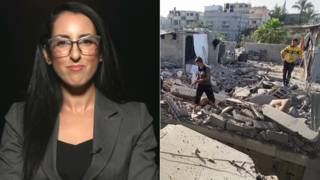

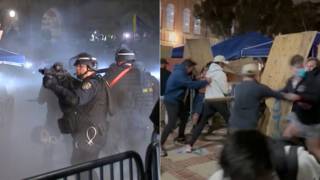
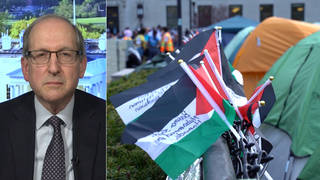





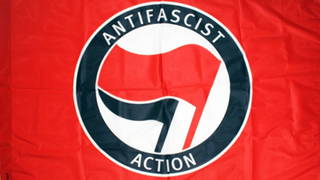
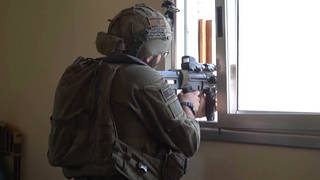
Media Options